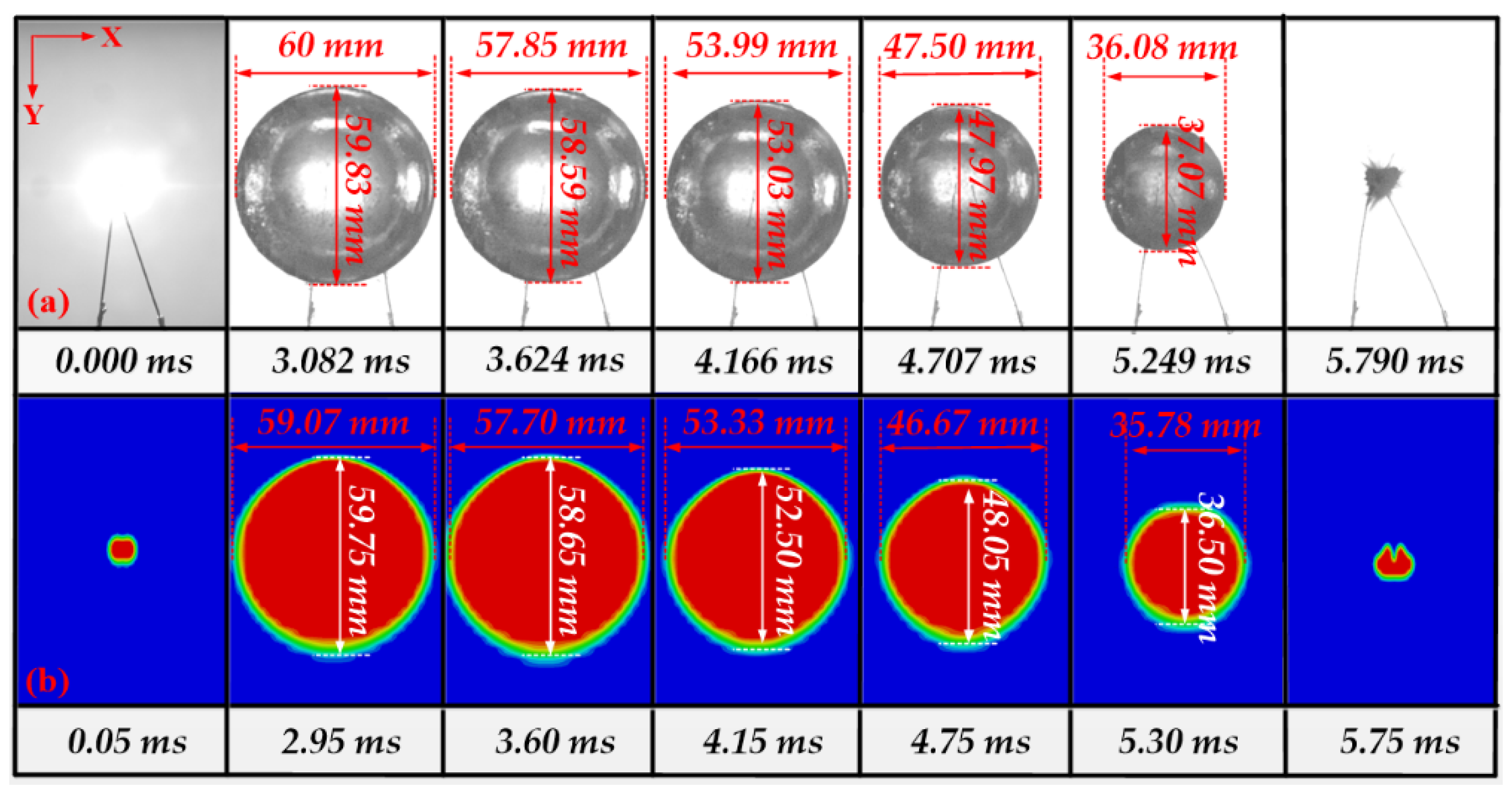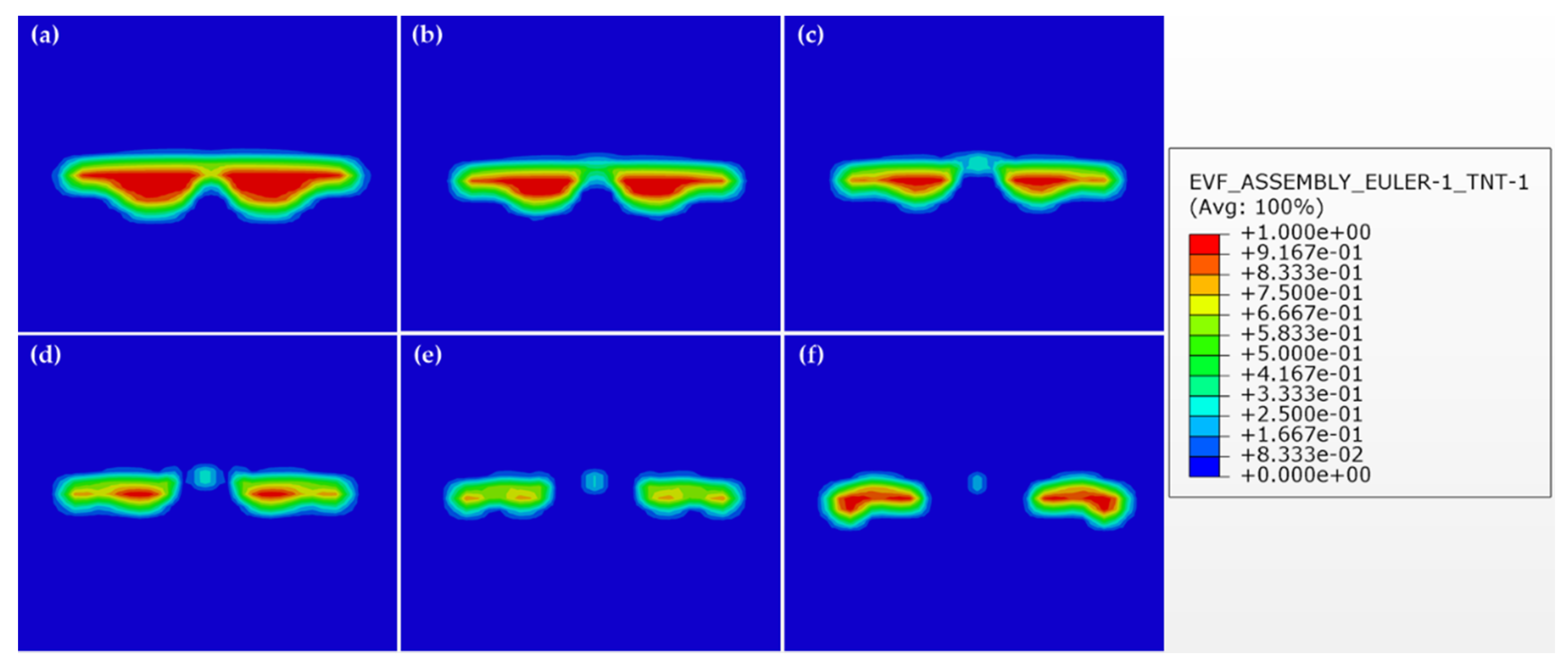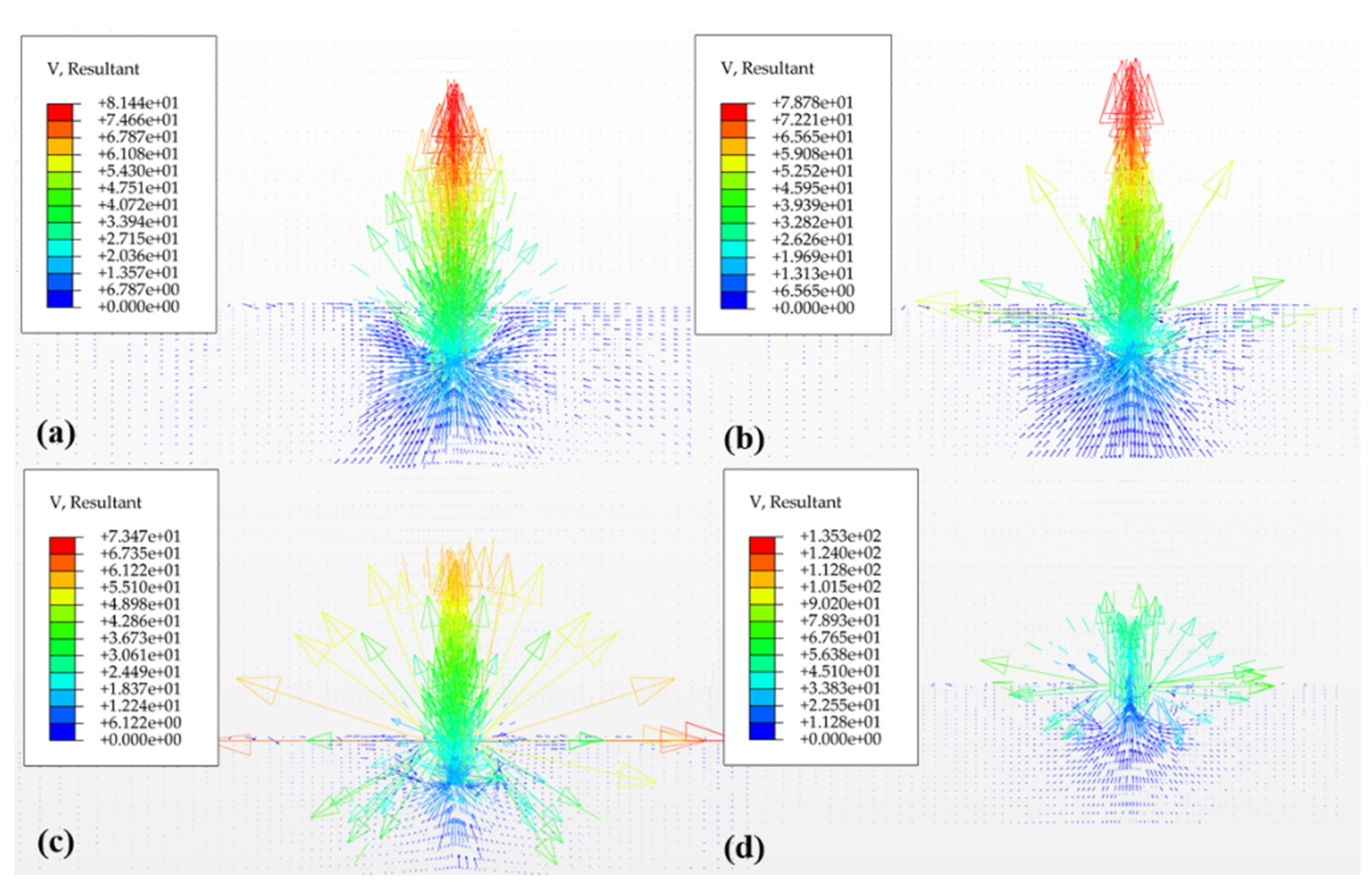Numerical Study of the Pulsation Process of Spark Bubbles under Three Boundary Conditions
Abstract
:1. Introduction
2. Experimental Research
3. Numerical Research
3.1. Numerical Research Method
3.1.1. Finite Element Method
3.1.2. - Equation of State
3.1.3. Ideal Gas Equation of State
3.1.4. Surface Tension
3.2. Model Description
4. Results and Comparison
4.1. Free Field
4.2. Flat Plate Target
4.2.1. γ = 0.33 in Flat Plate Target
4.2.2. γ = 0.83 in the Flat Plate Target
4.3. Hemisphere Target
4.3.1. γ = 0.33 in the Hemisphere Target
4.3.2. γ = 0.83 in the Hemisphere Target
5. Conclusions
Author Contributions
Funding
Institutional Review Board Statement
Informed Consent Statement
Data Availability Statement
Conflicts of Interest
References
- Wang, S.-P.; Zhang, A.-M.; Liu, Y.-L.; Zhang, S.; Cui, P. Bubble dynamics and its applications. J. Hydrodyn. 2018, 30, 975–991. [Google Scholar] [CrossRef]
- Gibson, D.C.; Blake, J.R. Growth and collapse of cavitation bubble near flexible boundaries. In Proceedings of the 7th Australasian Hydraulics and Fluid Mechanics Conference, Brisbane, Australia, 18–22 August 1980. [Google Scholar]
- Han, R.; Tao, L.; Zhang, A.M.; Li, S. Experimental and numerical investigation of the dynamics of a coalesced oscillating bubble near a free surface. Ocean Eng. 2019, 186, 106096. [Google Scholar] [CrossRef]
- Goh, B.H.T.; Gong, S.W.; Ohl, S.-W.; Khoo, B.C. Spark-generated bubble near an elastic sphere. Int. J. Multiph. Flow 2017, 90, 156–166. [Google Scholar] [CrossRef]
- Ma, X.; Huang, B.; Zhao, X.; Wang, Y.; Chang, Q.; Qiu, S.; Fu, X.; Wang, G. Comparisons of spark-charge bubble dynamics near the elastic and rigid boundaries. Ultrason. Sonochem. 2018, 43, 80–90. [Google Scholar] [CrossRef]
- Zhang, M.; Chang, Q.; Ma, X.; Wang, G.; Huang, B. Physical investigation of the counterjet dynamics during the bubble rebound. Ultrason. Sonochem. 2019, 58, 104706. [Google Scholar] [CrossRef]
- Ma, C.L.; Shi, D.Y.; Li, C.; Wang, M.N.; He, D.Z. Experimental Research on the Electric Spark Bubble Load Characteristics under the Oblique 45 Degree Curved Surface Boundary. J. Mar. Sci. Eng. 2021, 9, 32. [Google Scholar] [CrossRef]
- Cui, P.; Wang, Q.X.; Wang, S.P.; Zhang, A.M. Experimental study on interaction and coalescence of synchronized multiple bubbles. Phys. Fluids 2016, 28, 012103. [Google Scholar] [CrossRef] [Green Version]
- Tian, Z.-L.; Liu, Y.-L.; Zhang, A.M.; Tao, L.; Chen, L. Jet development and impact load of underwater explosion bubble on solid wall. Appl. Ocean Res. 2020, 95, 102013. [Google Scholar] [CrossRef]
- Zhang, A.M.; Wang, S.-P.; Huang, C.; Wang, B. Influences of initial and boundary conditions on underwater explosion bubble dynamics. Eur. J. Mech. B/Fluids 2013, 42, 69–91. [Google Scholar] [CrossRef]
- Ma, C.L.; Shi, D.Y.; Chen, Y.Y.; Cui, X.W.; Wang, M.N. Experimental Research on the Influence of Different Curved Rigid Boundaries on Electric Spark Bubbles. Materials 2020, 13, 3941. [Google Scholar] [CrossRef]
- Phan, T.H.; Nguyen, V.T.; Park, W.G. Numerical study on strong nonlinear interactions between spark-generated underwater explosion bubbles and a free surface. Int. J. Heat Mass Transf. 2020, 163, 120506. [Google Scholar] [CrossRef]
- Costanzo, F.; Surface, N.; Boulevard, M. Underwater Explosion Phenomena and Shock Physics. In Structural Dynamics; Springer: New York, NY, USA, 2011; Volume 3, pp. 917–938. [Google Scholar]
- Tian, Z.-L.; Liu, Y.-L.; Zhang, A.M.; Tao, L. Energy dissipation of pulsating bubbles in compressible fluids using the Eulerian finite-element method. Ocean Eng. 2020, 196, 106714. [Google Scholar] [CrossRef]
- Daramizadeh, A.; Ansari, M.R. Numerical simulation of underwater explosion near air–water free surface using a five-equation reduced model. Ocean Eng. 2015, 110, 25–35. [Google Scholar] [CrossRef]
- Beig, S.A.; Aboulhasanzadeh, B.; Johnsen, E. Temperatures produced by inertially collapsing bubbles near rigid surfaces. J. Fluid Mech. 2018, 852, 105–125. [Google Scholar] [CrossRef]
- Wu, W.B.; Zhang, A.M.; Liu, Y.L.; Wang, S.P. Local discontinuous Galerkin method for far-field underwater explosion shock wave and cavitation. Appl. Ocean Res. 2019, 87, 102–110. [Google Scholar] [CrossRef]
- Qin, Z.; Alehossein, H. Heat transfer during cavitation bubble collapse. Appl. Therm. Eng. 2016, 105, 1067–1075. [Google Scholar] [CrossRef]
- Petrov, N.V.; Schmidt, A.A. Multiphase phenomena in underwater explosion. Exp. Therm. Fluid Sci. 2015, 60, 367–373. [Google Scholar] [CrossRef]
- Simulia ABAQUS 6.11. ABAQUS Analysis User’s Manual; HKS Inc.: Providence, RI, USA, 2011. [Google Scholar]
- Ma, C.; Shi, D.; Cui, X.; Chen, Y. A New Measurement Based on HPB to Measure the Wall Pressure of Electric-Spark-Generated Bubble near the Hemispheric Boundary. Shock. Vib. 2020, 2020, 1–20. [Google Scholar] [CrossRef] [Green Version]
- Lew, K.S.F.; Klaseboer, E.; Khoo, B.C. A collapsing bubble-induced mircopump: An experimental study. Sens. Actuators A 2007, 133, 161–172. [Google Scholar] [CrossRef]
- Brujan, E.A.; Keen, G.S.; Vogel, A.; Blake, J.R. The final stage of the collapse of a cavitation bubble close to a rigid boundary. Phys. Fluids 2002, 14, 1. [Google Scholar] [CrossRef] [Green Version]
- Pearson, A.; Cox, E.; Blake, J.R.; Otto, S.R. Bubble interactions near a free surface. Eng. Anal. Bound Elem. 2004, 28, 295–313. [Google Scholar] [CrossRef]
- Liu, N.N.; Ming, F.R.; Liu, L.T.; Ren, S.F. The dynamic behaviors of a bubble in a confined domain. Ocean Eng. 2017, 144, 175–190. [Google Scholar] [CrossRef]
- Li, Z.-R.; Sun, L.; Zong, Z.; Dong, J. A boundary element method for the simulation of non-spherical bubbles and their interactions near a free surface. Acta Mech. Sin. 2012, 28, 51–65. [Google Scholar] [CrossRef]
- Liu, N.N.; Cui, P.; Ren, S.F.; Zhang, A.M. Study on the interactions between two identical oscillation bubbles and a free surface in a tank. Phys. Fluids 2017, 29, 052104. [Google Scholar] [CrossRef]
- Wang, S.; Duan, W.; Wang, Q. The bursting of a toroidal bubble at a free surface. Ocean Eng. 2015, 109, 611–622. [Google Scholar] [CrossRef]
- Zhang, Y.L.; Yeo, K.S.; Khoo, B.C.; Wang, C. 3D jet impact and toroidal bubbles. J. Compt. Phys. 2001, 166, 336–360. [Google Scholar] [CrossRef]
- Zhang, Y.L.; Yeo, K.S.; Khoo, B.C.; Chong, W.K. Three-dimensional computation of bubbles near a free surface. J. Compt. Phys. 1998, 146, 105–123. [Google Scholar] [CrossRef]
- Wang, Q.X.; Yeo, K.S.; Khoo, B.C.; Lam, K.Y. Vortex ring modeling of toroidal bubbles. Theor. Comput. Fluid Dyn. 2005, 19, 303–317. [Google Scholar] [CrossRef]
- Zhang, A.M.; Yao, X.L.; Li, J. The interaction of an underwater explosion bubble and an elastic–plastic structure. Appl. Ocean Res. 2008, 30, 159–171. [Google Scholar] [CrossRef]
- Li, J.; Rong, J.-L. Bubble and free surface dynamics in shallow underwater explosion. Ocean Eng. 2011, 38, 1861–1868. [Google Scholar] [CrossRef]
- Chisum, J.E.; Shin, Y.S. Explosion gas bubbles near simple boundaries. Shock Vib. 1997, 4, 11–25. [Google Scholar] [CrossRef]
- Abe, A.; Katayama, M.; Murata, K.; Kato, Y.; Tanaka, K. Numerical study of underwater explosions and following bubble pulses. In Proceedings of the 15th APS Topical Conference on Shock Compression of Condensed Matter, Kohala Coast, HI, USA, 24–29 June 2007. [Google Scholar]
- Barras, G.; Souli, M.; Aquelet, N.; Couty, N. Numerical simulation of underwater explosions using an ALE method. The pulsating bubble phenomena. Ocean Eng. 2012, 41, 53–66. [Google Scholar] [CrossRef]
- Plesset, M.S.; Prosperetti, A. Bubble dynamics and cavitation. Ann. Rev. Fluid Mech. 1997, 9, 145–185. [Google Scholar] [CrossRef]
- Simulia, D. Abaqus Version 2016 Documentation; Dassault Systems Simulia Corp: Providence, RI, USA, 2012. [Google Scholar]
- Li, X.; Zhang, C.; Wang, X. Research on the Influence of Water State Equation on Underwater Explosion. Eng. Mech. 2014, 31, 46–52. [Google Scholar]
- Prior, M.K.; Brown, D.J. Estimation of depth and yield of underwater explosions from first and second 826 bubble-oscillation periods. Ocean. Eng. 2010, 35, 103–112. [Google Scholar] [CrossRef]
- Shen, F.; Wang, H.; Yuan, J. A Simple Algorithm for Determining the Parameters of JWL State Equation. Vib. Shock. 2014, 9, 107–110. [Google Scholar]






























| Free Field | Flat Plate Target | Hemispherical Target | |
|---|---|---|---|
| Simulated explosion source (TNT) | 0.001 g | 0.001 g | 0.001 g |
| Explosion source water depth | 265 mm | 265 mm | 265 mm |
| Explosion distance | — | 10 mm | 10 mm |
| 25 mm | 25 mm |
| Free Field | Flat Plate Target | Hemispherical Target | |
|---|---|---|---|
| Discharge voltage | 400 V | 400 V | 400 V |
| Explosion source water depth | 265 mm | 265 mm | 265 mm |
| Explosion distance | — | 10 mm | 10 mm |
| 25 mm | 25 mm |
Publisher’s Note: MDPI stays neutral with regard to jurisdictional claims in published maps and institutional affiliations. |
© 2021 by the authors. Licensee MDPI, Basel, Switzerland. This article is an open access article distributed under the terms and conditions of the Creative Commons Attribution (CC BY) license (https://creativecommons.org/licenses/by/4.0/).
Share and Cite
Ma, C.; Shi, D.; Li, C.; He, D.; Li, G.; Lu, K. Numerical Study of the Pulsation Process of Spark Bubbles under Three Boundary Conditions. J. Mar. Sci. Eng. 2021, 9, 619. https://doi.org/10.3390/jmse9060619
Ma C, Shi D, Li C, He D, Li G, Lu K. Numerical Study of the Pulsation Process of Spark Bubbles under Three Boundary Conditions. Journal of Marine Science and Engineering. 2021; 9(6):619. https://doi.org/10.3390/jmse9060619
Chicago/Turabian StyleMa, Chunlong, Dongyan Shi, Chao Li, Dongze He, Guangliang Li, and Keru Lu. 2021. "Numerical Study of the Pulsation Process of Spark Bubbles under Three Boundary Conditions" Journal of Marine Science and Engineering 9, no. 6: 619. https://doi.org/10.3390/jmse9060619







